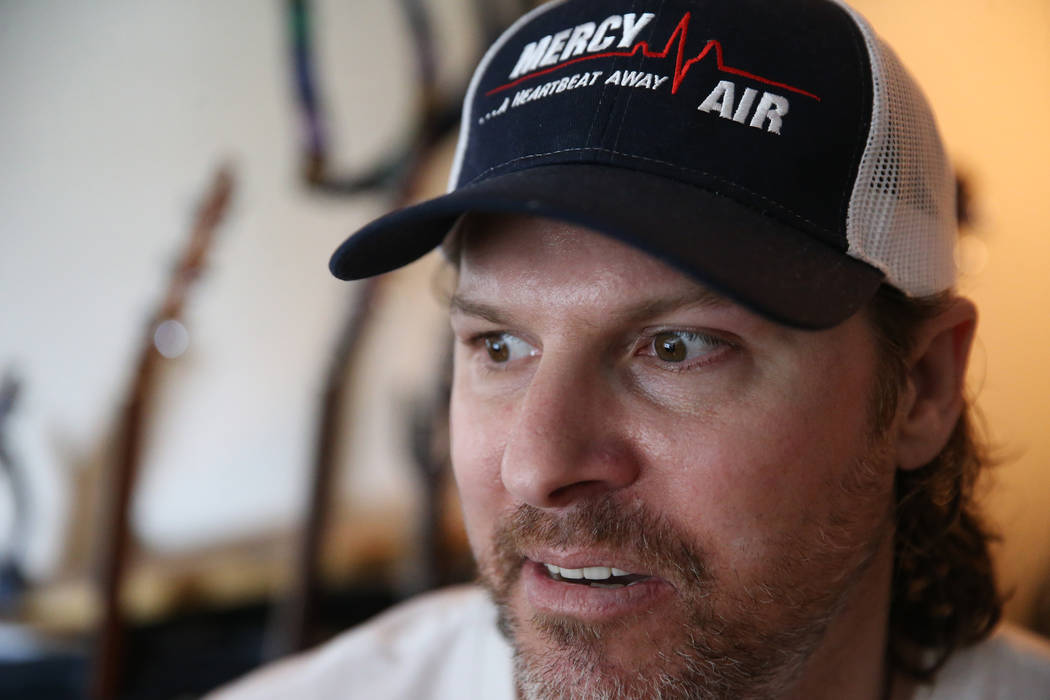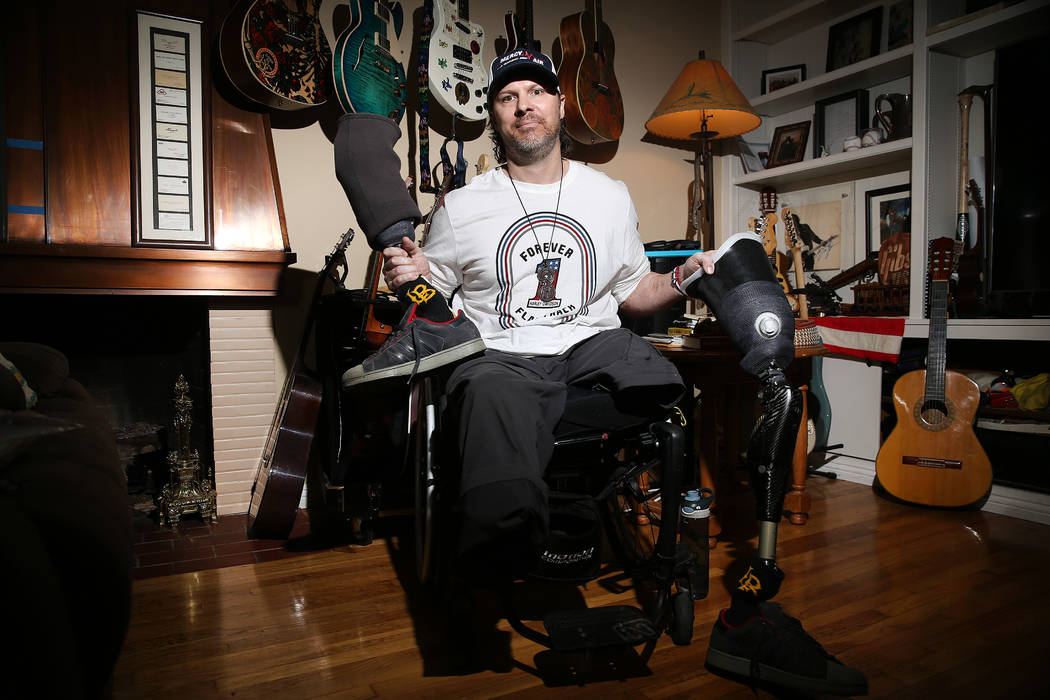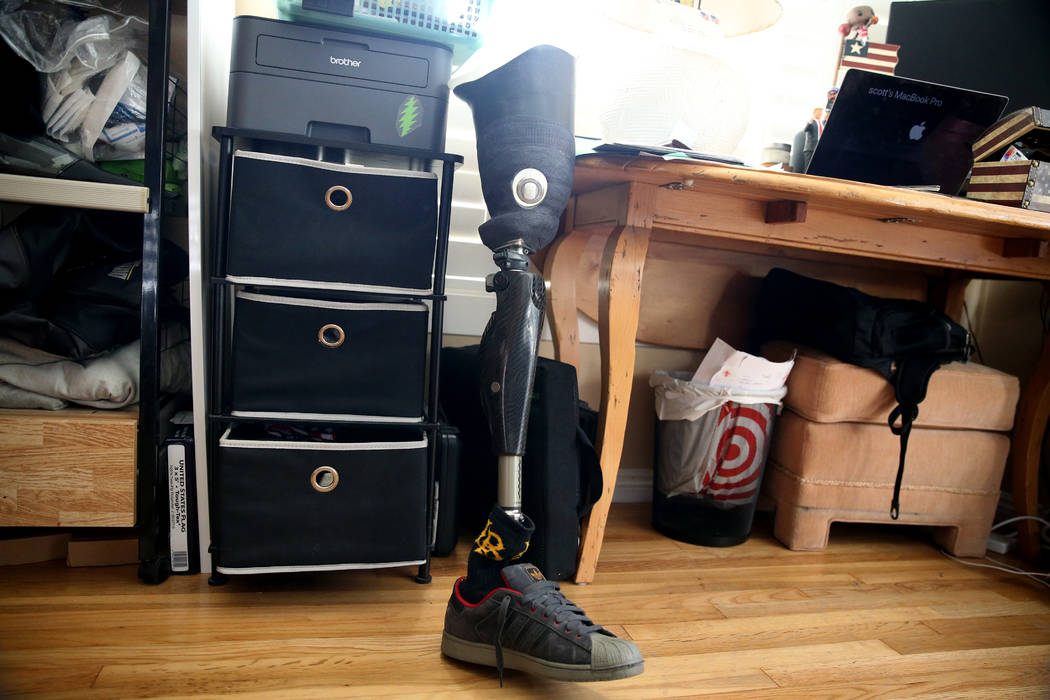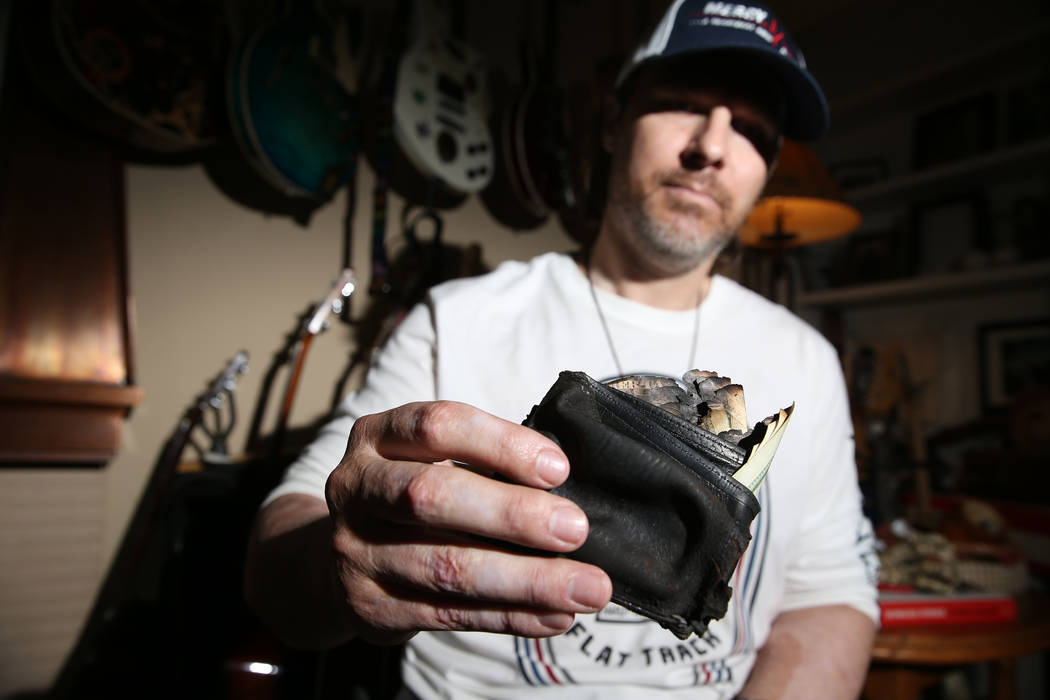Pilot in Grand Canyon crash campaigns for safer helicopters
LONG BEACH, Calif. — Scott Booth woke up about 65 feet from the burning helicopter to the sounds of screams and a woman praying over him.
His clothes were burned off, except for the fabric directly underneath him. His face and hair were singed.
Booth, 43, survived the impact and subsequent fire, but the crash that would eventually claim the lives of five people also took his legs. Now he hopes sharing his story of recovery can spark change in the helicopter industry and prevent similar fallout in other crashes.
“I want justice for myself, for all the passengers involved, and I want to make sure that this never happens again,” Booth said from his parents’ Long Beach home.
Feb. 10, 2018, started normally for Booth. Though he wasn’t initially scheduled to fly that day for Papillon Grand Canyon Helicopters, he picked up the shift.
On the pilot’s third flight from Papillon’s Boulder City base, the British tourists seemed happy. He gave them the safety briefing, and they were joking around.
“It was just a flight like every other flight, and then it wasn’t,” he said.
He intended to land the EC130 B4 sightseeing helicopter in Quartermaster Canyon on tribal land in Arizona. But on approach, the helicopter spun to the left at least twice as it fell out of the sky and into the wash below.
Booth has no recollection of the impact or how he was freed from the helicopter.
‘They were spread everywhere’
Flight nurse Cambria Hilgers, who was working with her partner in Kingman, Arizona, was dispatched to the canyon.
Their rescue helicopter had to circle a couple of times in the high winds before it could land near the Quartermaster picnic area. They hiked down the rugged terrain to the wreckage, where she saw a still-burning fuselage and a detached tail.
“People were still very much alive, and they were writhing in pain and they were yelling,” she said. Their cries echoed through the canyon.
Her focus was on the patients.
“I had four different people, and they were spread everywhere,” she said.
When Hilgers got to Booth, she covered him up. He was raspy, his throat was swelling and he cycled through emotions. Both legs were broken from the knee down.
“The right leg was just charred all the way through,” she said.
Hilgers continued talking with Booth to keep him alive. When he started to fade, she yelled at him, forcing him to come around.
Eight hours would pass before rescue crews could lift the victims from the canyon. In that time, Hilgers formed a bond with Booth that continues today.
Three of the passengers died at the scene: Becky Dobson, 27; Jason Hill, 32; and Stuart Hill, 30. Booth and three other passengers were taken to Las Vegas. Newlyweds Ellie Milward Udall, 29, and Jonathan Udall, 31, died at University Medical Center in the days after the crash. Jennifer Barham survived.
All five deaths were due to burn-related injuries.
Months in hospitals
Booth’s mother, Kathy Booth, was in her kitchen in Long Beach when she heard the phone ring close to midnight. Her son’s friend asked where Scott was. She was interrupted by the police calling.
An operator told her an official from the National Transportation Safety Board called but couldn’t get through. She was asked to call the agency.
“So then I knew something was pretty bad,” she said.
By the time she’d packed, she had heard her son was out and talking. She thought it was only broken bones; she never considered a fire or losing a limb.
When she arrived at the hospital, she saw her son on a ventilator. It was hot in the room, and he was bloating.
“He was very scary to look at,” she said.
Doctors quickly amputated Booth’s left leg, which was fractured and burned in the crash. They would remove his right leg later because it was severely burned, he recalled.
Kathy Booth visited her son at the University Medical Center burn unit in weeklong intervals, trading off time between watching over him and caring for her husband, who suffers from dementia, back home. She advocated for her son when she said the quality of care he received didn’t meet standards.
Scott Booth struggled with not being able to talk to the people who visited him in the hospital.
“Everyone was gowned up,” he said. “They had gloves and long sleeves and gowns and masks, so I didn’t even know who was visiting me. I could just see eyes.”
After about four months, he was taken to Torrance Memorial Medical Center in California, where he would spend an additional three months in a burn unit. He recalled crying fits because he didn’t want to spend his life in a wheelchair.
Going home
After another month in a Long Beach hospital, Booth went back to the home where he grew up.
Now his days are filled with medication.
Kathy Booth upended her lifestyle to care for her son. She lost sleep because she wanted to be available if he needed her.
“This is your child, so you want to blow on it and kiss it and make it go away, but it doesn’t work like that,” she said.
Scott Booth has undergone dozens of surgeries since he was hospitalized.
The scars from his skin grafts will be visible forever. Though he no longer requires regular treatment for his burns, he is seeking plastic surgery to deal with loose skin from grafting.
Most recently, he had titanium rods put into his legs, which will allow him to click his legs into his prosthetics. The prosthetic legs he was given are too painful to regularly wear over his burns.
Despite the physical limitations, Booth has found ways to carry on. He can drive a vehicle with hand controls, and he’s taking boxing lessons.
He later reconnected with one of the nurses who cared for him in Las Vegas. Now, Elisabeth Wolf is his fiancee. “I think he’s kind of super human,” she said.
Invisible scars
Booth said he was devastated when he found out the harm the crash had caused. He still is, but one thought keeps him going.
“I know I’m not responsible,” he said. “That’s the only thing that keeps me sane. I didn’t do it. I didn’t cause that accident.”
The fire took nearly half his body and scarred much of the rest, but the hardest part of recovery has been healing the psychological wounds.
As someone who has traveled the world, he wrestles with the fact that he can’t move the way he once did.
“I mean, how do you take someone that was in Mount Everest three months before the accident and put him in a bed?” he asked, choking back tears. His brain still wants to travel, but his body is broken, he said.
He’s experienced suicidal thoughts and wondered if he would ever walk again. The little things that people take for granted got to him, like standing up to go to the bathroom or putting up Christmas lights.
“I just was hoping to get through the day,” he said.
Booth will be able to walk again with prosthetics, but he knows his life is forever changed.
“You put it all into perspective, though, in the long run, there’s time, right?” he said. “I’m still going to have time.”
Lawsuits and loopholes
A lawsuit from Jonathan Udall’s family that names Papillon, Booth and Airbus Helicopters among the defendants claims Udall’s death could have been prevented. The lawsuit blames a faulty tail rotor, failed weather checks and pilot inexperience for causing the helicopter to spin out of control and crash into the canyon. It says if the helicopter had been outfitted with a crash-resistant fuel system, Udall would have survived.
Booth also has filed a claim against Airbus, blaming the crash and his extensive injuries on a defective tail rotor and the lack of a crash-resistant fuel system.
Airbus would not comment on potential causes of the crash and referred all questions to the NTSB. An NTSB spokesman did not respond to a voicemail.
There’s no final report that spells out the cause of the crash or explicitly says whether the helicopter was equipped with a crash-resistant fuel system. But two things are clear: Such systems were not standard equipment on the model of helicopter that crashed, and the manufacturer did not provide an option for an upgrade at the time.
After the wreck, Papillon reached an agreement with a third-party company to retrofit its fleet with safer tanks. That project has been completed.
Airbus says it complies with all applicable certification regulations.
But a loophole in a 1994 federal aviation regulation allowed helicopter makers to sidestep a requirement to put crash-resistant fuel tanks in new aircraft. The regulation requires all newly certified helicopters to be equipped with the systems, but it grandfathers in newly built aircraft with certificates approved before the regulation was implemented. The helicopter that crashed was a derivative of a pre-regulation model.
In 2015, a federal transportation safety official wrote that only 15 percent of new helicopters had the rupture-resistant systems.
An Airbus spokeswoman said the company didn’t make the rupture-resistant tanks standard largely because it was not required and it wasn’t a big topic in the industry when the EC130 B4 was certified about 20 years ago.
The systems also came with added weight and added cost. The company’s crash-resistant fuel systems are about 40 pounds heavier than the original systems, the spokeswoman said.
An Airbus crash-resistant tank retrofit kit will be certified soon for the type of helicopter that crashed, the company said. And on current Airbus production models, crash-resistant fuel systems are standard on all aircraft in the same class as the Papillon tour helicopter that crashed.
A law signed in October 2018 requires newly manufactured helicopters to have the safer fuel systems, but the new standards only apply to helicopters built 18 months after the law was enacted, aviation lawyer Mike Slack said.
“Everything before that date is not subject to the new law,” he said. The law does not contain any retrofitting requirements, he said.
Booth said he thinks there should be a requirement to add safer tanks to commercial aircraft. Compared to the total cost of a helicopter, it doesn’t take much to make the aircraft safer, he said.
“It’s a fraction of a percent to make sure the fuel systems are crash-resistant,” Booth said. “Changing the material, changing what it’s encapsulated in. That’s what I want. That’s important, right?”
Contact Blake Apgar at bapgar@reviewjournal.com or 702-387-5298. Follow @blakeapgar on Twitter.
No retrofit requirement
Although the FAA Reauthorization Act of 2018 does not require helicopters to be retrofitted with safer fuel systems, it does contain language to expedite certification and validation for retrofit kits that improve fuel system safety.
Within 180 days of the law's enactment, the Federal Aviation Administration was required to issue a bulletin to inform owners and operators of available modifications to improve fuel system safety, and urge that those modifications be installed as soon as practicable.
























